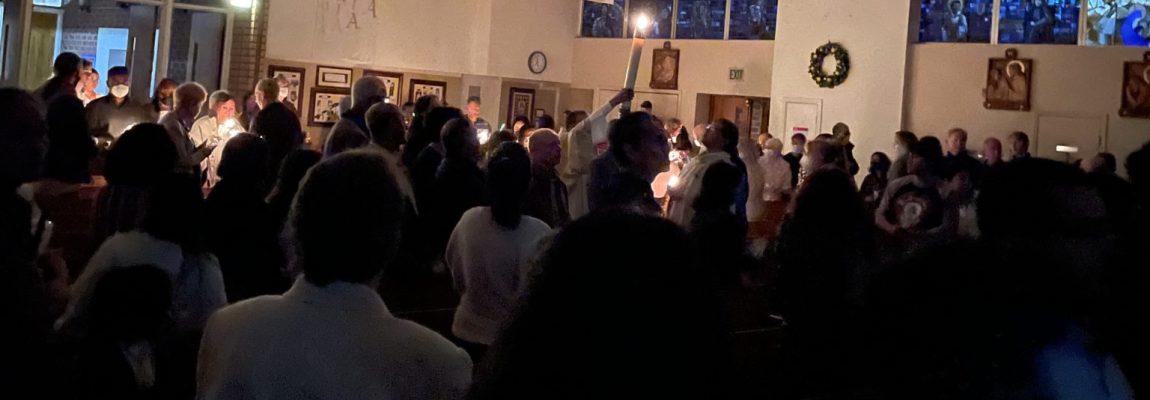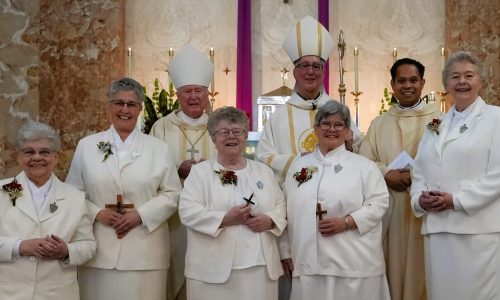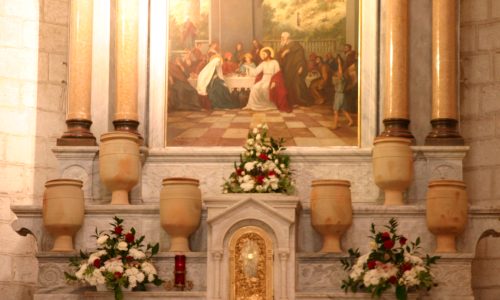by Sister Diane Heiss, SDSH
Picture of the Easter Vigil taken by a Sacred Heart Sister
With a sense of excitement, Catechumens have long been gathering since sunset on Holy Saturday, the evening before Easter, along with their families and friends.
They were accompanied by their Christian sponsors who had been regularly instructing them in the faith and mentoring them in living as disciples and friends of Jesus. They had also observed a period of some weeks before their baptism in more intense prayer and fasting. The time had finally arrived for them to receive the Sacraments of Baptism, Confirmation and the Eucharist.
Soon the bishop arrived, and they were ready to commence. A third century text entitled the “Apostolic Tradition” (commonly attributed to Hippolytus of Rome) describes how the celebration took place, far longer than our current experience. The entire night was spent listening to Scripture readings and instructions which served as a review of all they had been learning. When the time arrived for the Rite of Baptism, the Catechumens were anointed; turned to the West, representing darkness and renounced Satan and sin; turned to the East, symbolizing the light, while professing their faith in God; removed their clothing before baptism, illustrating their detachment from sin and turning away from their old way of life; and after baptism put on white clothing signifying their purity and new life in Christ. They were also confirmed, then joined the Christian community for the celebration of the Eucharist (Mass) and received their first Holy Communion.
What we experience today as three separate Sacraments, celebrated at different moments in time throughout a Christian’s life, were previously always celebrated together as the Sacraments of Initiation (Baptism, Confirmation/Chrismation and Holy Communion) and the bishop was the celebrant of all three. (We see these sacraments administered together now when anyone who is unbaptized and over the age of 7 is received into the Church – that is to say, the sacraments of initiation are conferred together during the Easter Vigil).
Roman law during the first three centuries of our Catholic Christian faith forbade Christianity, and those arrested were given the choice of denying their faith or losing their lives. Therefore, the time of baptismal preparation could last several years, to ascertain people were firm in their desire to say “Yes” to Christ and willing to give their lives, if the need should arise, for Jesus who out of His great personal love for each of us freely offered His life. With the rapid spread of Christianity after its legalization in 313 (C.E. – common era or A.D. – Anno Domini, year of Our Lord) by the Emperor Constantine, some practices were continued and others adapted or eliminated. The process of preparing for Easter evolved over the centuries to its current form, including a period of six and a half weeks before Easter commencing on Ash Wednesday, known as Lent. This 40-day period of fasting and abstinence (excluding Sundays) was inspired by the 40 days that Jesus spent in prayer and fasting before beginning his public ministry and initially was for the catechumens (those preparing for baptism) and grave sinners doing public penance before being readmitted to the Eucharist. Eventually, acknowledging the fact that we are all sinners in need of repentance and conversion, the observance of Lent spread until it became the norm for all.
With Your Family:
- Observe the Church laws of Fast and abstinence: Do not eat meat on Ash Wednesday or any of the Fridays of Lent. On Ash Wednesday and Good Friday, eat only one full meal and two small meals which together do not equal the one full meal.
- Attend daily Mass, when possible, along with Mass on Sunday (or Saturday vigil at 4 p.m.)
- Prayer, Penance and Almsgiving (acts of charity) are traditional Lenten practices. Choose how you want to observe this as a family and what each family member will “give up” as a means of spiritual renewal and self-discipline.
- Go to confession; make amends to those you have harmed; offer Works of Mercy.
- Gather around a “Prayer Corner” (place a Bible, candle and crucifix on a table covered in a nice tablecloth) to read the Sunday Gospel together.
Published in Orange County Catholic paper 2/13/2024 – Click for original article



